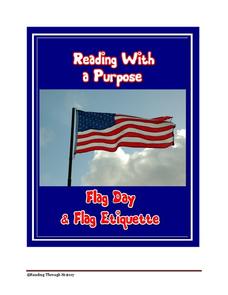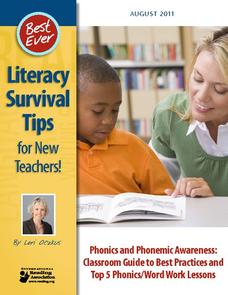Library of Congress
Stars, Stripes and Symbols of America: Comparing Our Flag, Past and Present
Your young historians will compare and contrast the details of the American flag today with an an image of the nation's flag from the post-Civil War era, and identify the flag's importance as a national symbol through analysis worksheets...
BrainPOP
U.S. Symbols
United States symbols are the subject of a video brought to you by BrainPop Jr. Hosts, Annie and Moby, begin with a definition of the word symbol, then go on to detail ten American symbols—the American flag, a Bald Eagle, the Liberty...
National Gallery of Canada
Reading Symbols
Introduce your upper-elementary students to printmaking. Class members view prints, select and research symbols in a piece, and create their own sets of prints using styrofoam trays. Pupils can wash off the paint on their trays to make...
Academy of American Poets
Teach This Poem: "A New National Anthem" by Ada Limón
Ada Limon's poem, "A New National Anthem," offers young scholars an opportunity to reflect on the significance of the US national anthem and the extent to which Key's vision applies to all Americans. After watching a video of Whitney...
Franklin D. Roosevelt Presidential Library & Museum
The Power of Propaganda in Shaping Civic Actions and Understanding
Propaganda posters are powerful. Using images from The Art of War: American Poster Art 1941-1945 exhibit, young historians analyze the symbols, images, colors, and text used to rally support for World War II. Through seven activities,...
US House of Representatives
“The Fifteenth Amendment in Flesh and Blood,” The Symbolic Generation of Black Americans in Congress, 1870–1887
New ReviewThe reading of a contextual essay launches a study of Black Americans who served in Congress from 1870 through 1887. Young historians identify the African Americans who served during this period, investigate the ways they won national...
Reading Through History
Flag Day
Why is the United States flag such an important symbol to America that it gets its own day to celebrate it? Pupils read a passage that discusses the symbolism and significance of the American flag. Following the reading, they answer quiz...
National Center for Families Learning
Hidden Flags
Scholars scour a city landscape to locate twenty-five hidden flags. After each discovery, the narrator offers a piece of information about the American symbol. When all flags are found, a fireworks display appears in celebration of a job...
Federal Reserve Bank
U.S. Income Inequality: It's Not So Bad
What is the difference between a flat tax, progressive tax, tax deduction and transfer payments? Pupils examine the ability-to-pay principle of taxation through discussion, problem solving, and a variety of worksheets on topics from US...
National Woman's History Museum
Martha Hughes Cannon: Doctor, Wife, Mother, Senator
Each state is entitled to two statues in the National Statuary Hall Collection in Washington, D.C. After reading about Utah's debate over whether or not Martha Hughes Cannon should be represented by one of their statues, individuals...
Penguin Books
An Educator Guide to Call Us What We Carry by Amanda Gorman
Call Us By What We Carry, a poetry collection by Nation Youth Poet Laureate Amanda Gorman, is the focus of a 10-page teacher's guide.
National Woman's History Museum
How Do We Remember and Honor the Contributions of Women in Public Space?
Public art, especially monuments and memorials, are designed to celebrate and honor those who have made significant contributions to a community or even an entire nation. Here's a lesson that asks scholars to consider who is represented...
Dick Blick Art Materials
Peace Windows
Peace, love, tolerance, faith. Marc Chagall's Peace Window in the United Nations World Headquarters serves as a model for young artists as they create their own peace-themed transparent paintings. A great activity for both SPED and...
National Museum of the American Indian
To Honor & Comfort Native Quilting Traditions
"Native American history leaps boldly off the colorful quilts and patchwork designs." Learners discuss Native American identity and symbolism by reading about a variety of Native quilters and their unique art process, and participate in...
National Gallery of Canada
Make a Parfleche
Examine American Indian art and culture by observing contemporary art and creating original pieces. Class members discuss artwork included in the plan and use these images to help inspire their own work, which should represent their...
PBS
The Sixties: Dylan Plugs in and Sells Out
Before Woodstock, there was Newport. Get plugged in to the social changes of the 1960s with a lesson that looks at Bob Dylan's performance at the 1965 Newport Folk Festival as a symbol of the radical changes that marked the era.
Duluth-Superior Area Educational Television Corporation
Marc Chagall / Magic Realism
Surrealistic painters like Marc Chagall and Wendy Rouse show viewers an expansive world in a small area. Young artists have a opportunity to create their own surrealistic paintings in response to a study of works by Chagall and Rouse.
US National Archives
The Royal Seal What Can It Tell Us?
Analyze the images and details of the Great Seal of Queen Elizabeth I, and discover clues that reveal how one of the greatest monarchs in the history of England wished to be seen and respected. This is a great way to discuss how even to...
Curated OER
How to Celebrate Kwanzaa on Your Campus
An article details everything you need to know about celebrating Kwanzaa at your school. An opening-day ceremony starts the seven-day holiday celebration followed a daily routine that includes a greeting, candle lighting, reciting an...
Delegation of the European Union to the United States
Cultural Identity
How does cultural diversity impact political identity? That is the question researchers face as they continue their examination of the European Union and the programs it has developed in its attempt to achieve unity in diversity. To gain...
International Reading Association
Literacy Survival Tips for New Teachers!
Whether new to teaching or a seasoned pro, this 12-page phonics and phonemic awareness guide is a must for your curriculum library. Everything from a summary of research on the topic to exercises and activities is included.
Royal Canadian Legion
Teachers' Guide: Take Time to Remember
The Royal Canadian Legion offers this teacher's guide designed to remind learners of all ages of the sacrifices made by Canadian soldiers in not only World War I but also the Korean and Gulf wars. The 42-page packet is filled with...
NET Foundation for Television
1850-1874 Notable Nebraskan: J. Sterling Morton
What are the characteristics of an outstanding citizen? Nebraskan J. Sterling Morton contributed to the formation of societal and family values in his state. Learners gather information on Morton's life accomplishments from primary...
Classics for Kids
"Mars" from The Planets
Gustav Holst's The Planets provide young musicians an opportunity to examine how composers can create a suite: a collection of smaller pieces grouped to explore a single topic. After listening to "Jupiter," they examine "Mars" in detail,...
Other popular searches
- American National Symbols
- Canadian National Symbols
- Us National Symbols
- Essay on National Symbols
- National Symbols Essay
- U.s. National Symbols
- State and National Symbols
- National Symbols in History
- National Symbols Bahamas
- Symbols of National Pride
- Symbols National Pride
- National Symbols Bald Eagle

























